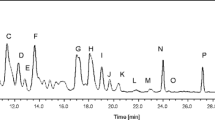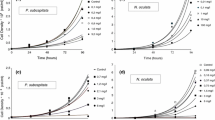Abstract
Caulerpa taxifolia (Vahl) C. Agardh (Ulvophyceae, Caulerpales) is an alga of tropical origin that was accidentally introduced into the Mediterranean sea in 1984, where this species can reach an abundance that has never been described in tropical endemic regions. It is known that caulerpacean algae can develop an efficient strategy against grazers consisting of the synthesis of repulsive of toxic secondary metabolites: we report here the first study of the toxicity of purified secondary metabolites and raw extracts fromC. taxifolia from the Mediterranean.
Toxicity was evaluated on three models: mice (lethality), mammalian cells in culture (cytotoxicity) and sea urchin eggs (disturbance of cell proliferation). Aqueous extracts are only active on fibroblasts and mice. In the three toxicity models a seasonal variation of toxicity is observed for the crude methanol extract as well as a decrease of this activity whenC. taxifolia from the Mediterranean is kept in aquaria. Pure compounds exhibit different toxicity depending on the assay. 10,11-epoxycaulerpenyne is the most active substance on mice and fibroblasts whereas taxifolial A and D are inactive or only weakly toxic. Among the four tested compounds caulerpenyne, the major metabolite ofC. taxifolia, is the most active on sea urchin eggs. Caulerpenyne may therefore represent an ecological risk for microorganisms and the eggs of multicellular animals living close to this alga. The ecological impact of this toxicity on marine organisms and the interaction of this alga with the herbivorous fauna are discussed.
Similar content being viewed by others
References
Aguilar-Santos G (1970) Caulerpin, a new red pigment from green algae of the genusCaulerpa. J. chem. Soc. 92: 842–843.
Aguilar-Santos G, Doty MS (1968) Chemical studies on three species of the marine algal genusCaulerpa. In Freudenthal HD (ed.), Drugs from the Sea. Marine Technological Society XXX: 173–177.
Aguilar-Santos G, Doty MS (1971) Constituents of the green algaCaulerpa Lamourouxii. Lloydia 34: 88–90.
Amico V, Oriente G, Piatelli M, Tringali C (1978) Caulerpenyne, an unusual sesquiterpenoid from the green algaCaulerpa prolifera. Tetrahedron Lett.: 3593–3596.
Bheemasankara Rao C, Pullaiah KC (1982) Chemical examination of marine algae of Visakhapatnam Coast: constituents ofCaulerpa taxifolia (Vahl) C. Agardh. Indian J. Chem. 21 B: 264–265.
Biyiti L, Pesando D, Puiseux-Dao S, Girard JP, Payan P (1990) Effect of antibacterial plant flavanones on the intracellular calcium compartment involved in the first cleavage of sea urchin eggs. Toxicon 28: 275–283.
Blackman AJ, Wells RJ (1978) Flexilin and trifarin, terpenes 1,4-diacétoxybuta-1,3-dienes from twoCaulerpa species (Chlorophyta). Tetrahedron Lett.: 3063–3064.
Borenfreund E, Puerner JA (1985) Toxicity determinedin vitro by morphological alterations and neutral red absorption. Tox. Lett. 24: 119–124.
Boudouresque CF, Meinesz A, Verlaque M, Knoeffler-Peguy M (1992) The expansion of the tropical algaCaulerpa taxifolia (Chlorophyta) in the Mediterranean. Cryptogamie Algologie 13: 144–145.
Chevaldonne P (1990) Ciguatera and the saupe,Sarpa salpa (L.), in the Mediterranean: a possible misinterpretation. J. Fish Biol. 37: 503–504.
Cimino G, Crispino A, Di Marzo V, Gavagnin M, Ros JD (1990) Oxytoxins, bioactive molecules produced by the marine opisthobranch molluscOxynoe olivacea from a diet-derived precursor. Experientia 46: 767–770.
Dini F, Guerriero A, Giubbilini P, Meinesz A, Pesando D, Durand-Clément M, Pietra F (1992) Ciliates as a probe for biological pollution produced by the seaweedCaulerpa taxifolia. The Third Asian Conference on Ciliate Genetics Cell Biology and Molecular Biology, Shenzhen University, Shenzen China.
Doty MS, Aguilar-Santos G (1966) Caulerpicin, a toxic constituent ofCaulerpa. Nature 211: 990.
Doty MS, Aguilar-Santos G (1970) Transfer of toxic algal subtances in marine food chains. Pacif. Sci. 24: 351–355.
Epel D (1978) Mechanisms of activation of sperm and egg during fertilization of sea urchin gametes. Current Topics in Developmental Biology 12: 186–246.
Everett JL, Kun GAR (1950) The preparation of some cytotoxic epoxydes. J. chem. Soc.: 3131–3135.
Faulkner DJ (1984) Marine natural products: metabolites of marine invertebrates. Natural Product Reports 1: 552–598.
Fusetani N (1987) Marine metabolites which inhibit development of echinoderm embryos. In Scheuer PJ (ed.), Bioorganic Marine Chemistry 1: 61–92.
Gillot I, Payan P, Girard JP, Sardet C (1990) Calcium in sea urchin egg during fertilization. Int. J. devl Biol. 34: 117–125.
Guerriero A, Meinesz A, D'Ambrosio M, Pietra F (1992) Isolation of toxic and potentially toxic sesqui- and monoterpenes from the tropical green seaweedCaulerpa taxifolia which has invaded the region of Cap Martin. Helv. Chim. Acta 75: 689–695.
Hay ME (1981) Spatial patterns of grazing intensity on a caribbean barrier reef: herbivory and algal distribution. Aquat. Bot. 11: 97–109.
Hodgson E (1987) Measurement of toxicity. In Hodgson E, Levi PE (eds), Modern Toxicology. Elsevier, Amsterdam, 233–243.
Hodgson LM (1984) Antimicrobial and antineoplastic activity in some South Florida seaweeds. Bot. Mar. 27: 387–390.
Hose JE (1985) Potential use of sea urchin embryos for identifying toxic chemicals: description of a bioassay incorporating cytologic, cytogenic and embryologic endpoints. J. appl. Toxicol. 5: 245–254.
Jacobs RS, Wilson L (1986) Fertilized sea urchin eggs as a model for detecting cell division inhibitors. In Aszalos A (ed.), Modern Analysis of Antibiotics. New York and Basel, 480–493.
Lewis SM (1985) Herbivory on coral reefs: algal susceptibility to herbivorous fishes. Oecologia 65: 370–375.
Lima Ainouz I, Holanda Sampaio A (1991) Screening of Brazilian marine algae for hemagglutinins. Bot. Mar. 34: 211–214.
Littler MM, Taylor PR, Littler DS (1983) Algal resistance to herbivory on a Caribbean barrier reef. Coral Reefs 2: 111–118.
Mahendran M, Somasundara S, Thomson RH (1979) A revised structure for caulerpicin fromCaulerpa racemosa. Phytochemistry 18: 1885–1886.
Maiti BC, Thomson RH (1977) Caulerpin. In Faulkner DJ, Fenical WH (eds), Marine Natural Products Chemistry. Plenum Press, New York, 159–164.
Maiti BC, Thomson RH (1978) The structure of Caulerpin, a pigment fromCaulerpa algae. J. chem. Res. (M): 1682–1690.
Malpezzi ELA, Freitas JC (1990) Antimitotic effect of an extract of the sea anemoneBunodosoma caissarum on sea urchin egg development. Brazilian J. med. biol. Res. 23: 811–814.
McConnell OJ, Hughes PA, Targett NM, Daley J (1982) Effects of secondary metabolites from marine algae on feeding by the sea urchin,Lytechinus variegatus. J. chem. Ecol. 8: 1437–145.
McGibbon S, Moldan AG (1986) Routine toxicity testing of toxicants using a sea urchin gamete bioassay. Mar. Pollut. Bull. 17: 68–78.
Meinesz A, Hesse B (1991) Introduction et invasion de l'algue tropicaleCaulerpa taxifolia en Méditerranée nord-occidentale. Oceanologica Acta 14: 415–426.
Meinesz A, De Vaugelas J, Hesse B, Mari X (1993) Spread of the introduced tropical green algaCaulerpa taxifolia in northern Mediterranean waters. J. appl. Phycol. 5: 141–147.
Nielsen PG, Carle JS, Christophersen C (1982) Final structure of caulerpicin, a toxic mixture from the green algaCaulerpa racemosa. Phytochemistry 21: 1643–1645.
Norris JN, Fenical W (1982) Chemical defense in tropical marine algae. In Rutzler K, Macintyre IG (eds), Atlantic Barrier Reef Ecosystem, Carrie Bow Cay Belize. 1. Structure of Communities. Smithsonian Contrib. Mar. Sci. 12, 417–431.
Patterson GML, Norton TR, Furusawa E, Furusawa S, Kashiwagi M, Moore RE, (1984) Antineoplastic evaluation of marine algal extracts. Bot. Mar. 27: 485–488.
Paul VJ, Fenical W (1985) New bioactive terpenoids from tropical Pacific marine algae of the family of Udotcaceae (Chlorophyte). Phytochemistry 24: 2239–2243.
Paul VJ, Fenical W (1986) Chemical defense in tropical green algae, order Caulerpales. Mar. Ecol. Prog. Ser. 34: 157–169.
Paul VJ, Fenical W (1987) Natural Products Chemistry and Chemical Defence in Tropical Marine Algae of the Phylum Chlorophyta. In Scheuer PJ(ed.), Bioorganic Marine Chemistry. Springer-Verlag, Berlin, 1–29.
Pesando D, Graillet C, Breakman JC, Dubreuil A, Girard JP, Puiseux-Dao S (1991a) The use of sea urchin eggs as a model to investigate the effects of crassolide, a diterpene isolated from a soft coral. Tox.in vitro 5: 395–401.
Pesando D, Girard JP, Durand-Clement M, Payan P, Puisseux-Dao S (1991b) Effect of maitotoxin on sea urchin egg fertilization and on Ca 2 + permeabilities of eggs and intracellular stores. Biol. Cell. 72: 269–273.
Rueness J (1989)Sargassum muticum and other introduced Japanese macroalgae: biological pollution of European Coasts. Mar. Pollut. Bull. 20: 173–176.
Schwartz RE, Hirsch CF, Sesin DF, Flor JE, Chartain M, Fromtling RE, Harris GH, Salvatore MJ, Liesch JM, Yudin K (1990) Pharmaceuticals from cultured algae. J. Ind. Microb. 5: 113–124.
Schwede JG, Cardellina JH, Grode SH, James TR, Blackman AJ (1987) Distribution of the pigment caulerpin in species of the green algaCaulerpa. Phytochemistry 26: 155–158.
Spanier E, Finkelstein Y, Raikhlin-Eisenkraft B (1989) Toxicity of the saupe,Sarpa salpa (Linnaeus, 1758), on the Mediterranean coast of Israel. J. Fish. Biol. 34: 635–636.
Vidal JP, Laulent D, Kabore SA, Rechenck E, Boucard M, Girard JP, Escale R, Rossi JC (1984) Caulerpin, caulerpicin,Caulerpa scalpelliformis comparative acute toxicity study. Bot. Mar. 27: 533–537.
Whitaker M, Swan K, Crossley I (1989) What happens during the latent period at fertilization. In Nucitelli R, Cherr GN, Clark WH (eds), Mechanisms of Egg Activation. Plenum Press, New York, 157–172.
Author information
Authors and Affiliations
Rights and permissions
About this article
Cite this article
Lemée, R., Pesando, D., Durand-Clément, M. et al. Preliminary survey of toxicity of the green algaCaulerpa taxifolia introduced into the Mediterranean. J Appl Phycol 5, 485–493 (1993). https://doi.org/10.1007/BF02182507
Received:
Revised:
Accepted:
Issue Date:
DOI: https://doi.org/10.1007/BF02182507




